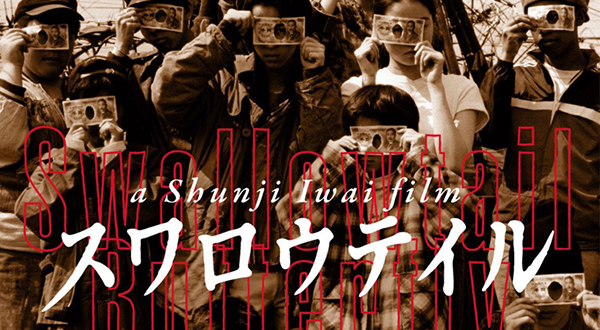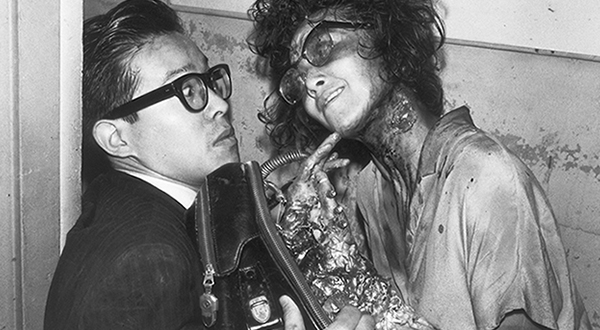Attention fellow denizens of the Big Apple; once again, it’s the most wonderful time of the year! No, not Christmas (though Xmas in NYC is pretty damn nice); am talking about the New York Asian Film Festival! And for the 15h summer in a row, ASIAN FILMS ARE GO…
And as usual, I’ll do my best to be your tour guide; for those in New York City, these are the movies you should be spending money towards instead of that Ghostbusters reboot. Even if it ends up being decent, you’ll have your chance to see it on Netflix eventually, whereas in the case of some (perhaps most) of the films I’ll be touching upon, this may be your best (and only) bet to catch them. As for those of you who aren’t in New York City, um, sorry?
So, what’s up first? Well, two indie classics from Japan. One of which somewhat contradicts my sales pitch, since it is widely available, whereas the other, despite being super influential, is something I’m confident most have not even heard of…
Swallowtail Butterfly

The recipient of this year’s New York Asian Film Festival Lifetime Achievement Award is Iwai Shunji, with three of his movies being showcased. And Swallowtail Butterfly is to this year’s NYAFF as Nobuhiko Obayashi’s House was to the festival in 2009. In the sense that, here we have yet another legitimately groundbreaking/profoundly influential motion picture that hardly anyone outside of its homeland has ever heard of. The NYAFF states that it occupies “pretty much the same cultural territory in Japan that Pulp Fiction occupies in America”, and even though I’m not intimately familiar with Japanese cinema that immediately preceded its debut (in 1996; yes, exactly 20 years ago), I have seen much that came after so it’s amazing to view perhaps the one single film most responsible for the look and feel of late 90s/early 00s Japanese cinema as a whole. And while I doubt it’ll become as celebrated in the West as House ended up being, I can still easily imagine Swallowtail Butterfly being embraced thanks to being so ahead of the curve, especially all the points made regarding multiculturalism.
Taking place in an alternate near future, the Yen has become the world’s most sought after currency, prompting a massive influx of immigrants to Japan. The outsiders live in shantytowns that surround the major cities called Yen Towns, and the xenophobic Japanese refer to these outsiders as Yen Thieves. Though the more commonly used term is Yet Towns as well, which sounds confusing, but there’s actually a reason behind this, one that’s never explained (though if you’re curious, Google is your friend). The story begins with the death of a Chinese prostitute, who leaves behind an unnamed daughter; not only do they pillage whatever money she had managed to save, the dead mother’s associates also end being piss poor caretakers. Eventually the girl with no name ends up with a Chinese prostitute with a heart of gold, Glico, who ends up being a proper guardian. One of Glico’s first kindhearted gestures is coming up with a name for her ward: Ageha, or “swallowtail butterfly”. Glico also introduces Ageha to Fei-hong, who leads a pack of equally warm and fuzzy hustlers; by day he’s orchestrating small time cons and by night he’s serving food and drinks to fellow Yen Towners.
Things officially kick off into high gear when a customer of Glico’s steps over the line and ends up falling out of her apartment window, then crushed by a garbage truck. While disposing of the body, the gang discovers an audiocassette tape that appears to just be a recording of Frank Sinatra’s “My Way” and only that. Turns out, there’s data hidden that fools ATMs into believing a 1,000-yen note is a 10,000-yen note. So the change that results is a 9,000-yen profit, and what does Fei-hong do with his newfound riches? Why, open a nightclub in the heart of the city, where the Yentown flavor is the main dish. The audition for the house band is when we encounter the only other individual, aside from Ageha, who best personifies Swallowtail Butterfly’s essence in its purest form. That being a smooth talking white guy who, aside from having no name as well, gives the aforementioned Yentown flavor a specific name: “Third Culture Music”. He also dub themselves “Third Culture Kids”; his story is how his parents were American, but he was born and raised in Japan, and thanks to abysmal educational system, so he wonders out loud who he is exactly, American or Japanese, given that he’s always treated like a foreigner by looks alone, despite growing up in Japan and considers nowhere else to be “home” (much like Ageha).
It’s also worth pointing out that pretty much every Yentowner/Third Culture Kid speaks multiple languages, yet that still doesn’t mean everyone understands each other; Fei-hong, for example, is from China and often uses English to converse, even with fellow Chinese, yet doesn’t understand a word of Japanese, which means Ageha has to serve as translator. Anyhow, Fei-hong’s master plan is to make Glico a pop singing sensation (did I mention that she’s portrayed by an actual Japanese pop star?) and the plan totally works. As well as predictably backfires; the record company decide to take control of their star by shedding that less than desirable Yentown image, and also enacts a plan to get her boyfriend/manager out of the picture (yup, Fei-hong is her bf). Starting here in which the narrative kinda gets unwieldy; Ageha at this point is also the leader of a bunch of street kids, who had previously tried bullying her, and she ends up overdosing on drugs. It’s nothing more than a set up for her to cross paths with the gangster with a heart of gold, Ryou Ryanki, who’s on the hunt for that missing tape with the valuable counterfeit info. Thankfully the movie lets the audience know early on that Ryou and Glico are siblings that were separated in their youth, cuz a reveal towards the end would have been a real groaner.
Though the film is chock full of other cliches, as well as mighty heavy-handed at times, though I honestly don’t believe it’s substantially worse than what you find in Japanese cinema across the board. As is often the case, it’s all in the details; one can’t help but admire an independent production with a modest budget’s attempt to churn out an epic, and more or less succeeds. Thanks to some brilliant camerawork and deft art direction, though it helps that I appreciate the MTV’s 120 Minutes esthetic that is either intentionally or unintentionally tapped into; Swallowtail Butterfly is both ahead of its time plus a sign of its times. What ultimately helps the most is the colorful cast, one that saves the movie’s ass more than a few times. Like the unnamed doctor who first takes care of Ageha’s overdose and later provides a butterfly tattoo similar to Glico’s; the entire scene, in which Ageha recalls her earliest memory and has a rather eye-rolling epiphany, is still worth a damn thanks to the fine acting chops of the real life 50s rock star Mickey Curtis. In the end, Swallowtail Butterfly has issues; here we have yet another on the money description from the NYAFF: “seeing it today is like re-reading your high-school diary: the way it wears its heart on its sleeve can be cringe-inducing…” Though on a more serious note is the sensation that the film is a tad bit problematic, which others have discussed at length, specifically the way it fetishizes the plight of immigrants more than anything else. Yet I can’t help but buy into its youthful energy, while also forgive its naiveté; it’s so easy to see why the movie had such a massive impact. For those interested, it’s playing Saturday, June 25 at Lincoln Center.
Tetsuo: The Iron Man

I was originally going to review the other oldie by goodie by Iwai Shunji being shown at the Festival, All About Lily Chou-Chou, perhaps the filmmaker’s most celebrated work. Unfortunately I just couldn’t get into it. Sorry, but I’ve simply seen way far many movies about school kids treating each other like sh*t (a genre that the Japanese has absolutely mastered) to give another a shot. Even if it’s one of the finest according to the critics. Though alongside Swallowtail Butterfly’s 20th anniversary screening is a another film that’s serving as the poster child of the NYAFF’s 15th anniversary celebratory screening; as important Swallowtail Butterfly might be to the world of Japanese cinema, it could be easily argued that Tetsuo: The Iron Man’s impact and influence is far, far greater, not just at home but across the globe. The fact that there’s a decent chance that many reading this has seen it already is proof positive. Though I also take for granted that everyone’s familiar, so here we are!
Now, if Swallowtail Butterfly is the Pulp Fiction of the Japanese cinematic landscape, then Tetsuo: The Iron Man is either its Eraserhead or Videodrome, with a dash of Evil Dead 2. And that’s kinda all that needs to be said, though I’ll go on. First you have a guy, identified as the metal fetishist, who inserts a rod into his leg and later freaks out when noticing maggots in the wound (I would too, to be totally fair). While running down the street the fetishist is hit by a car, and behind the wheel is the salaryman. Who, along with his girlfriend, decide to dump the body in the woods. Then they immediately afterwards have sex right, there on the spot, in front of the body. Bad move! Cuz that’s how one invites a curse. Later the salaryman, while shaving, notices a small piece of metal on his cheek… not pierced into flesh, but coming out. Thus his troubles officially begin.
What follows is the salaryman being chased by a woman whose body has been taken over by the metal fetishist, and then a dream in which his gal pal is similarly transformed, whose newly formed snake like appendage is used to sodomize him. Afterwards the couple has sex, naturally, and then eat some sausages, again naturally. It’s at this point in which the salaryman discovers that a drill has replaced his penis; sadly, his girlfriend doesn’t survive. The metal fetishist then shows up, and as the salaryman slowly transforms, the two face off in a showdown that is as amazing as one could ever hope. Aside from the legit greatest final lines in a motion picture, ever, the very video game-like exclamation marks gets a big thumbs up from me also. Tetsuo is a classic in every sense of the word and deserves a serious look, even for those familiar. Cuz there’s a 95% chance the last time you saw it was during college on a sh*tty dorm room TV or at a bar on their slightly less sh*tty television. Whereas certain elements of Swallowtail Butterfly has not held up (as noted previously, an affinity for 90s music videos is a perquisite), boy oh boy has Tetsuo: The Iron Man aged like fine wine (the B&W 16mm visuals simply gorgeous, resulting in a genuine timeless quality; Tetsuo looks like it was either shot in 1950 or last week). Can’t wait to see it on the big screen at long last, this Saturday, June 25 at Lincoln Center as well.
